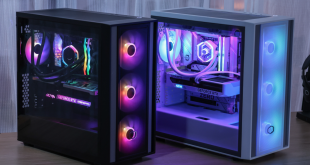Thermaltake positions the A31's large side panel window directly above the motherboard area, but wisely cuts it off as soon as the drive bays are reached. This helps to conceal the largely uninteresting storage area that can sometimes be laden with cables.
The right side panel continues the Chaser A31's gaming-inspired angular style. A protruded side panel is used to extend cable management clearance behind the motherboard tray.
Showing similarities to the colour scheme of a Tron movie, the Chaser A31's front panel uses eye-catching baby blue borders around each 5.25″ drive bay shield and the identical ‘mimic' covers.
Comprised of plastic, the front panel feels strong and exhibits a well-thought-out style that will appeal to gamers.
Recessed PCI slots and IO shield help to prevent unwanted interference with large cables exiting a graphics card or motherboard.
The Chaser A31 case's plastic top panel is easily removed by putting one's hand through the gap and pulling the cover away from the case.
The roof is also comprised of plastic, but as with the rest of Thermaltake's Chaser A31, the design should appeal to gamers.
A filtered mesh panel prevents the entry of dust via the A31's roof area. It also serves to protect any fans that may be installed in the roof mounts.
An indented holding area can be used to rest portable hard drives or media devices that are making use of the front panel connections. Thermaltake deserves credit for continuing to support this convenient design feature when many other case manufacturers remove it in favour of a uniform appearance.
Two USB 3.0 ports, audio jacks, and power and reset buttons form the front panel IO connections. A blue LED is located inside the power button to show when the system is active, and a red LED indicates HDD action.
Four plastic, non-rubberised feet lift the Chaser A31's bottom edge above the ground. The feet don't feel sturdy; they easily flex when a moderate amount of pulling or pushing force is applied. For users who keep their build in a single location, the plastic feet shouldn't be a major issue, as they are designed to enhance lifting capacity in the vertical direction.
It's users that move their chassis from side to side who may get caught out by the fasteners' and plastic material's lowered strength in horizontal directions.
The lack of rubberised feet is a cost-cutting decision that isn't necessary. Rubber tips would have increased the Chaser A31's production costs by a barely-noticeable margin. Plastic feet will transmit less sound than metal versions, but rubberised tips would have still managed to eliminate a greater amount of the noise-causing vibrations.
A large filter acts as the dust prevention mechanism for both the power supply fan and bottom 140mm unit, if installed.
 KitGuru KitGuru.net – Tech News | Hardware News | Hardware Reviews | IOS | Mobile | Gaming | Graphics Cards
KitGuru KitGuru.net – Tech News | Hardware News | Hardware Reviews | IOS | Mobile | Gaming | Graphics Cards









